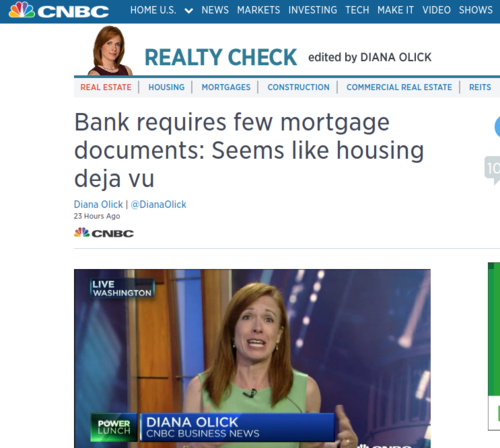Disingenuous CNBC Article Suggests Return of Low-Doc Mortgages Will Lead to New Housing Crisis
An article over at cnbc.com is sounding the alarm on the return of a type of mortgage loan that many held partly responsible for the crash in the U.S. housing market several years ago that led to the Great Recession.
The article, entitled ���Bank requires few mortgage documents: Seems like housing d��j�� vu,��� details the resurgence of stated income loans that allow borrowers to apply for mortgages with very limited documentation requirements. The loans are known either as ���low-doc��� or ���no-doc��� (although true ���no-doc��� loans have zero documentation requirements), and the bottom line is that they permit borrowers to obtain mortgage financing with really none of the traditional documentation requirements that are an intrinsic part of ���full-doc��� loans. They were originally created to assist applicants who had more complex professional and financial ���infrastructures,��� like the self-employed person with multiple entities ��� low-doc loans provide that person an easier, more manageable path to a mortgage. The trade-off is that borrowers end up with rates that are at least a few points higher than what they would pay they went with full documentation loans.
Stated loans became notorious in the wake of the housing crisis, as it was learned that a portion of those who ended up losing their homes in the wave of defaults had originally purchased them through the use of low-doc/no-doc financing. As a matter of fact, the term ���liar loan��� became a popular way to derisively refer to stated loans, as the specialized financing option became subject to weakened standards during the mania of the sub-prime housing boom, and people for whom the stated option was never originally intended became eligible borrowers.
The most pronounced failures of the stated option in the years leading up to the housing crash, it turns out, was both the ability of those with less-than-excellent credit to obtain a mortgage on a stated basis���and for the financing to be available at 100 percent, with no down payment required.
The problem with the CNBC article is that it hypes the return of stated loans (which, in truth, have been back for many years, as they disappeared only briefly following the crash) in a way that implies that one of the primary reasons for the debacle that began in 2008 has now landed back on our national economic doorstep.
There are a few problems with that, however.
For one thing, while the stated income loan became a convenient ���whipping boy��� of the housing crisis, there is no evidence that this type of product came anywhere close to being the predominant loan type originated during the peak of the subprime underwriting wave, from 2001 to 2007. Although it was common for politicians in the years that followed to holler about ���liar loans,��� fully underwritten loans were the standard of the day���and the real problem, as far as underwriting standards go, were those; at the height of the subprime lending boom in the early- to mid-2000���s, it was possible for a mortgage loan applicant, going the full documentation of income route, to obtain 100 percent financing with a credit score as low as 580 ��� who needed to lie about anything?
The bigger problem with the article is that, once you get past the worrisome headline and suggestions at the beginning of the piece that the Devil has reappeared, you find detailed a type of stated loan that is far different from the earlier versions. The article focuses on the ���Lite Doc��� loan product available today from New York City���s Quontic Bank. To illustrate the calculated ���flow,��� note that the third paragraph says ominously that the product ���requires only verification of employment and two months worth of bank statements. For self-employed borrowers, it requires documentation of one year of profit and losses.��� However, it is only when you get much further down into the article that other, stringent requirements of the ���Lite Doc��� loan are revealed, requirements that clearly make it a lot different from the low-doc/no-doc loans that have come before. For starters, a 40 percent down payment is required. Additionally, a borrower has to have a minimum credit score of 700, and must also be able to demonstrate at closing that he has a minimum of 12 months of PITI (principal, interest, taxes, and insurance) socked away in reserves. Plus, the product is not available for investment properties ��� owner-occupied only.
Sorry, but the borrower with a 700-plus credit score who can make a 40 percent down payment and have a full year of mortgage-related expenses set aside���is not the one who���s a threat to the U.S. economy.
The fact is that low- and no-documentation mortgage loans are terrific resources for people who have a more convoluted financial profile, like the professional entrepreneur. Full documentation underwriting requirements for people like that can be challenging. One of the biggest problems is that full-doc underwriting for the self-employed demands the review of two years of tax returns, and the numerous business deductions listed will lower net income, the figure in which lenders are interested when determining qualification. Limited doc loan options give those borrowers a viable alternative to securing financing; sweeping those options away entirely in the immediate aftermath of the housing crash was overkill, and, despite CNBC���s disingenuous alarm-sounding, it is nice to see that they are becoming increasingly available once again.
By Robert G. Yetman, Jr. Editor At Large




